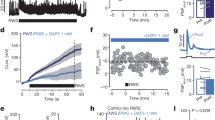Abstract
Bicuculline-filled microelectrodes were used to record responses to weak stimulation of the parietal cortex in field 5 of the motor cortex of anesthetized cats, and revealed late excitatory responses of neurons similar to those seen in the motor cortex of conscious cats in response to conditioned stimulation of the parietal cortex triggering a conditioned reflex consisting of placing the paw on a support. Tetanic stimulation of the parietal cortex (10–20 sec, 100 Hz) in the same conditions evoked long-term potentiation of late responses, resulting in the formation and enhancement of responses, along with decreases in the latent period of responses.
Similar content being viewed by others
References
V. I. Maiorov and B. V. Chernyshev, “Activity of cat motor cortex neurons during differentiation between responses consisting of placing the right and left paws on a support, acquired in response to stimulation of the parietal cortex of the different hemispheres,”Zh. Vyssh. Nerv. Deyat.,44, No. 2, 323 (1994).
V. I. Maiorov, B. V. Chernyshev, and A. A. Moskvitin, “The effects of 2-amino-5-phosphopentanoic acid (AP5), a blocker of NMDA glutamate receptors, on the activity of neurons in the cat motor cortex during performance of a conditioned reflex consisting of placing a paw on a support,”Zh. Vyssh. Nerv. Deyat.,47, No. 4, 672 (1997).
H. Asanama and A. Keller, “Neurobiological basis of motor learning and memory,”Concepts Neurosci.,2, 1 (1990).
M. F. Bear, W. A. Press, and B. W. Connors, “Long-term potentiation in slices of kitten visual cortex and the effects of NMDA receptor blockade,”J. Neurophysiol.,67, No. 4, 841 (1992).
M. A. Castro-Alamancos, J. P. Donoghue, and B. W. Connors, “Different forms of synaptic plasticity in somatosensory and motor areas of the neocortex,”J. Neurosci.,15, No. 7, 5324 (1995).
v. A. Doze, G. A. Cohen, and D. V. Madison, “Synaptic localization of adrenergic disinhibition in the rat hippocampus,”Neuron,6, No. 6, 889 (1991).
R. W. Dykes, “Acetylcholine and neuronal plasticity in somatosensory cortex,” inBrain Cholinergic Mechanisms, Oxford University Press, Oxford (1991), p. 224.
M. E. Hasselmo and E. Barkai, “Cholinergic modulation of activity-dependent synaptic plasticity in the piriform cortex and associative memory function in a network biophysical simulation,”J. Neurosci.,15, No. 10, 6592 (1995).
G. Hess and J. P. Donoghue, “Long-term potentiation of horizontal connections provides a mechanisms to reorganize cortical motor maps,”J. Neurophysiol.,71, No. 6, 2543 (1994).
E. D. Kanter and L. B. Haberly, “Associative long-term potentiation in piriform cortex slices requires GABAA blockade,”J. Neurosci.,13, No. 6, 2477 (1993).
A. Keller and H. Asanuma, “Synaptic relationships involving local axon collaterals of pyramidal neurons in the cat motor cortex,”J. Comp. Neurol.,336, 229 (1993).
W.-L. Lee and J. J. Hablitz, “Initiation of epileptiform activity by excitatory amino acid receptors in the disinhibited rat neocortex,”J. Neurophysiol.,65, No. 1, 87 (1991).
D. D. Rasmussen and R. W. Dykes, “Long-term potentiation of evoked potentials in cat somatosensory cortex produced by co-activation of the basal forebrain and cutaneous receptors,”Exptl. Brain Res.,70, No. 2, 276 (1988).
S. Retaux, M. J. Besson, and J. Penit-Soria, “Opposing effects of dopamine D2 receptor stimulation on the spontaneous and the electrically evoked release of [3H]GABA on rat prefrontal cortex slices,”Neuroscience,42, No. 1, 61 (1991).
T. Sakamoto, L. L. Porter, and H. Asanuma, “Long-lasting potentiation of synaptic potentials in the motor cortex produced by stimulation of the sensory cortex in the cat: a basis of motor learning,”Brain Res.,413, 360 (1987).
B. Sutor and J. J. Hablitz, “EPSPs in rat neocortical neurons in vitro. I. Electrophysiological evidence for two distinct EPSPs,”J. Neurophysiol.,61, No. 3, 607 (1989).
Author information
Authors and Affiliations
Additional information
Translated from Zhurnal Vysshei Nervnoi Deyatel'nosti, Vol. 49, No. 2, pp. 279–286, March–April, 1999.
Rights and permissions
About this article
Cite this article
Maiorov, V.I., Moskvitin, A.A. Long-term potentiation of the late NMDA-dependent components of neuron responses in the cat motor cortex to stimulation of the direct cortical input from field 5 of the parietal cortex. Neurosci Behav Physiol 30, 421–426 (2000). https://doi.org/10.1007/BF02463096
Received:
Accepted:
Issue Date:
DOI: https://doi.org/10.1007/BF02463096




